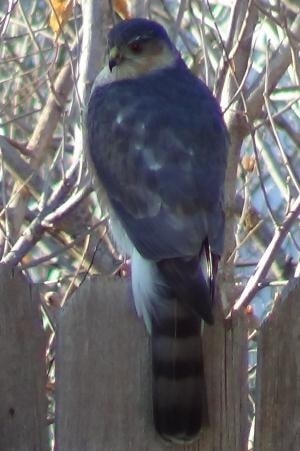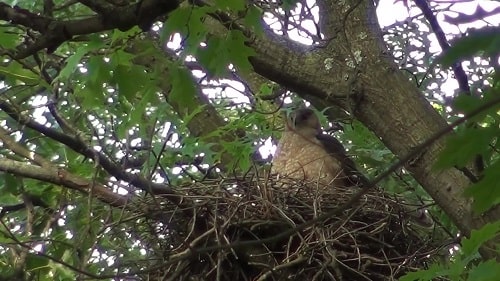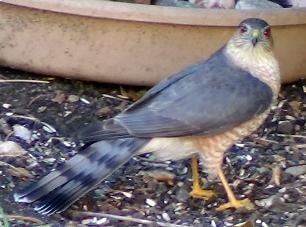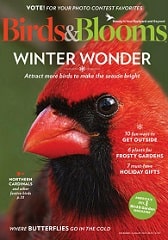Explore the Cooper's Hawk Mating, Nesting, and Feeding Habits
The bird's talons were visible enough to command respect from any would-be prey.
With breeding and nesting begining as early as late March, They'll spend the next 60 plus days building their nest, incubating eggs, and raising young.
Identifying: Size - Field Marks

Cooper's Hawk
The Cooper's Hawk is about 14 to 20 inches long with a wingspan that can measure 2 1/2 feet wide.
Short wings and a long rounded tail help this bird fly through wooded areas with ease.
The back is slate gray; the tail has several black bands, and the tip has a white band that is broader than the Sharp-shinned Hawk.
The bright yellow spot at the base of its gray bill along with its dark red eyes is hard to miss.
The female is similar in appearance but is larger than the male by about one-third.
Juveniles have brown backs with brown streaks on their breast and bright yellow eyes.
Courtship/Mating Breeding Habits
Courtship habits include flight displays and the male bowing around the female. This may give the message that he is ready to nest.
The breeding season for Cooper's hawks varies depending on the region and climate, but it typically occurs between March and April.
In the southern part of their range, breeding may begin as early as February, while in the northern parts, it may start later, around April.
Pairs are monogamous but do not mate for life. Some pairs may re-mate, but most will find new mates each season.
There is a pre-incubation period where the female stays in the nest stand all day. This may last a month.
During this time, the male will stay with her, leaving only to hunt for food.
The male will feed the female about three times a day, each time copulating with her.
Cooper's Hawk Nesting Habits
The male Cooper's Hawk migrates first to the breeding grounds, and it's speculated that he chooses the nesting site. More studies are needed.
Nest sites can be anywhere from 25 to 65 feet in a tree. Nests are placed in the tree's crotch or where the trunk and a horizontal branch meet.
While mostly building a new nest each season, they will occasionally reuse a nest or take over an old squirrel's nest. Nest takes about 2 weeks to complete.
Cooper's Hawk Nest
The nest is cup-shaped and made from twigs and small branches. The inside is lined with softer materials such as bark, grass, or leaves.

Female Cooper's on Nest
The female hawk is usually responsible for building the nest, while the male brings her materials.
Egg Laying, Incubation, Fledging
The female will lay her eggs every other day and averages 3 to 4 eggs in a clutch.
The female does most of the incubation, while the male brings food to her so she can stay at the nest.
Incubation (gestation period isn't the term) will last from 34 to 36 days. The female will brood the young for about two weeks.
The male brings food to the female, and she will tear it into smaller bits, and feed it to the young.
The young will be able to tear the food for themselves when they are about 2 1/2 to 3 weeks of age.
The young will leave the nest 28 to 32 days after hatching, but will return to the nest for some time after leaving.
| Cooper's Hawk Nesting Stats | |
|---|---|
| Eggs | 3 - 4 |
| Incubation | 34 - 36 days |
| Nestling Phase | 28- 32 days |
| Broods | 1 |
Within 2 months, the young will become independent and no longer need their parents.
Diet: What They Eat

The Cooper's Hawks diet consists of many types/species of birds. Some of these include Juncos, Robins, Jays, Doves, and other small birds.
They also eat a diet of small squirrels, mice, lizards, and insects.
Studies show that most of their prey is made up of first-year birds and mammals.
While they sometimes soar, most of their hunting is done by traveling specific routes and sitting on perches while they survey the area.
Cooper's and Sharp-shinned Hawks are known to take Purple Martins as they fledge right out of the air.
They also capture and eat adult Purple Martins using trees and human structures to ambush the birds.
What do They Feed Their Young?
Cooper's hawks primarily feed their young a diet of small to medium-sized birds, such as sparrows, finches, and doves.
They may also occasionally feed their young with small mammals, such as mice and chipmunks.
The adult hawks will hunt and capture prey, then bring it back to the nest to feed their young.
As the young grow and become more independent, they will begin to hunt for themselves and learn to catch their food.
Call
What are the Predators of Cooper's Hawk?
Cooper's hawks face several potential predators of their eggs and young. Some of the most common predators include:
Great horned owls, raccoons, squirrels, and some snake species will feed on adults, eggs, and young.
Other Cooper's hawks: In some cases, adult Cooper's hawks may prey on the eggs or young of other Cooper's hawk pairs.
To protect their eggs and young, Cooper's hawks will often aggressively defend their nests and may attack potential predators, including humans who get too close to their nest.
Do They Migrate?
While they do migrate, others farther North take their place as they migrate South.
Cooper's Hawk Has Caught A Mouse Under the Bird Feeders



